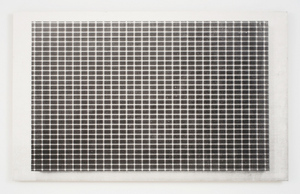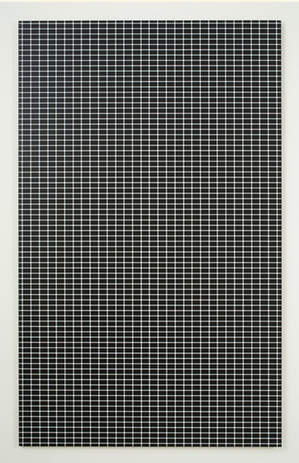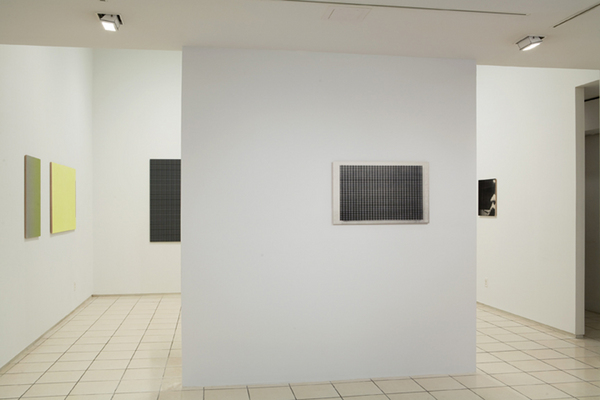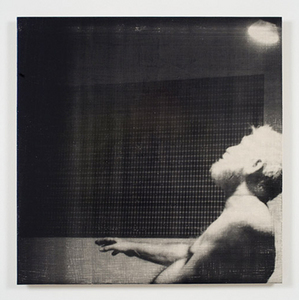This is an archive of the ArtCat Zine, 2007-2009. Please visit our new project, IDIOM.
R.H. Quaytman at Miguel Abreu
R. H. Quaytman: Chapter 12: iamb
Miguel Abreu Gallery, Through February 1, 2009
36 Orchard Street
What is so striking about chapter 12: iamb is the conversation between the paintings. I have rarely encountered a dialogue between pieces that is as subtle, as complex and as rewarding as the one at work in this show. This effect is magnified by the austerity of the works considered in isolation from each other, providing a visceral melancholy regarding their (presumably) oncoming separation. It is a remarkably palpable loss. There will, it seems to say, be little left for these paintings without each other.
It's a pointed critique, and one made with a unique level of commitment. Each piece seems to have a style almost unto itself, yet each shares a particular aspect or aspects with the other works located throughout the gallery. These little solidarities are precisely opposite the usual commonalities at work in painting exhibitions, which are iterations of a theme to be realized, at most, in one or two of the most ‘successful’ pieces. Here, the show is these relationships, these overlaps, which seem to orbit around an absent center, like old friends persisting long after the withering institutional affiliation that brought them together in the first place. These paintings do not want to appear to be the work of one artist, but of a school or a movement, a fictitious cohesion flickering for a brief moment like a distant, fading harmony amidst the gallery walls.
The point is not that the artwork, here specifically the painting, (with all of that mediums historical baggage) is not autonomous; the point is rather that the autonomy of a given painting is, in some sense, inevitable. Descriptively so – an individual painting is singular in a brutally material way – that is how it is sold. When I walked into the show one staff member was indicating to another which of the pieces had drawn interest. This is not so unusual, but it has never affected me in quite the way that it did here. Don't misunderstand. It is not that these paintings are somehow inadequate without each other; some in particular would hold up quite well, it’s just that without their being together we lose the (sometimes literal) sparkling of their collective idiom. The entire show seems to rehearse, in its own, devastatingly quiet sort of way, the corrosive work of capital on community, arguing that the injunction towards the autonomy of art has been, at best, a sort of theoretical performance of will – a determination to maintain a stiff upper lip in the face of a losing battle. It's a case made by a singular self-effacement -- and if Quaytman has a signature in this show, its here -- as these painting confess their attachment to each other in whispers and hints while meeting every headlong gaze with an almost pigheaded determination.
Consider the following three works from the installation view above. The first is hung offset right on the near wall, the second, all the way right on the far wall, and the third, on the right hand wall.


Each makes use of what is known as a scintillating grid, an optical illusion by which black dots appear and disappear as one looks on. In the first panel, the grid itself is framed by a white border, it consumes the entire field in the second, while in the third, the field is actually relocated as a representation into a figurative rendering. Thus, with three simple conceptual strokes Quaytman has detailed the fate of an illusion as it moves from something encountered as startling, if bracketed, to an all-consuming, inescapable phenomenon, to finally being assimilated into part of (something-like) lived experience. Earlier I read this as an allegory for our collective acclimation to the dominant mode of production, but one could just as easily encounter a host of other stories. What is important is that this is just one relationship in a show with dozens of equally high-functioning conceits, broken up and scattered amongst the works on display. I spent what seemed like forever chasing down different threads of color, line, and medium, consistently delighted at this reference, at that counterpoint, at visual tropes and tricks now implied, now explicit. In the end, as the works go their separate ways, it will all be over, but few shows have had such life when living.
ZINE
HOME
TIPS / COMMENTS
CATEGORIES
CONTRIBUTORS
- Greg Afinogenov
- B. Blagojevic
- Adda Birnir
- Susannah Edelbaum
- Julie Fishkin
- Paddy Johnson
- Jessica Loudis
- Christopher Reiger
- Andrew Robinson
- Peter J. Russo
- Blythe Sheldon
- S.C.Squibb
- Hrag Vartanian


